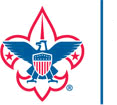Rank Advancement
Four Steps of Rank Advancement
A Scout advances from the Scout rank to Eagle by doing things with a patrol and troop, with adult and youth leaders, and independently. A well-rounded and active unit program that generates advancement as a natural outcome should enable Scouts to achieve First Class in their first 12 to 18 months of membership. Advancement is a straightforward matter when the four steps or stages outlined below are observed and integrated into troop programming.
The Scout Learns
With learning, a Scout grows in the ability to contribute to the patrol and troop. As Scouts develop knowledge and skills, they are asked to teach others and, in this way, they learn and develop leadership.
The Scout is Tested
The unit leader authorizes those who may test and pass the Scout on rank requirements. They might include the patrol leader, the senior patrol leader, the unit leader, an assistant unit leader, or another Scout.
The Scout is Reviewed
After completing all the requirements for a rank, except Scout rank, a Scout meets with a board of review. For Tenderfoot, Second Class, First Class, Star, and Life ranks, members of the unit committee conduct it.
The Scout is Recognized
When a Scout has earned the Scout rank or when a board of review has approved advancement, the Scout deserves recognition as soon as possible. This should be done at a ceremony at the next unit meeting. The achievement may be recognized again later, such as during a formal court of honor.
Rank Advancement
Scouting provides a series of surmountable obstacles and steps in overcoming them through the advancement method. Scouts plan their own advancement and progress at their own pace as they meet each challenge. Scouts are recognized and rewarded for each achievement, which helps them gain self-confidence. The steps in the advancement system help a Scout grow in self-reliance and in the ability to help others.
Advancement is the process by which youth members of the Boy Scouts of America progress from rank to rank and is the method by which we promote and encourage the ongoing involvement and commitment that keeps members coming back for more. It works best when it is built into a unit’s program so that simply participating leads to meaningful achievement and recognition—and to a continually improving readiness for more complex experiences.
Scouts need to purchase a Boy Scout Handbook, the official handbook of The Boy Scouts of America. In this handbook Scouts record their progress through the following Scout Ranks (links will direct you to the BSA website):
- Scout Rank Requirements PDF
- Tenderfoot Rank Requirements PDF
- Second Class Rank Requirements PDF
- First Class Rank Requirements PDF
- Star Rank Requirements PDF
- Life Rank Requirements PDF
- Eagle Rank Requirements PDF
- Eagle Palms Rank Requirements PDF
Additional Eagle Scout Information
An additional part of attaining the rank of Eagle requires you to present an Eagle Binder that compiles your achievements in Scouting. The following documents are needed for Eagle Advancement within our Troop:
- BSA Eagle Rank Application – This application is to be completed after the scout has completed all requirements for the Eagle Scout rank.
- BSA Eagle Rank Requirements – Eagle rank requirements
- Trail to Eagle – Eagle Path Flowchart provided by Paul Frenken
- BSA Eagle Rank Workbook – Eagle Workbook
- BSA Eagle Rank Checklist – Eagle Rank Checklist
- Gateway District Representatives – Advancement Contact Information


